« February 2013 | Main | April 2013 »
March 31, 2013
Coffee Break

Matt Damon and Hal Holbrook in Promised Land (Gus Van Sant - 2012)
Posted by Peter Nellhaus at 08:21 AM
March 28, 2013
Southeast Asian Independent Cinema
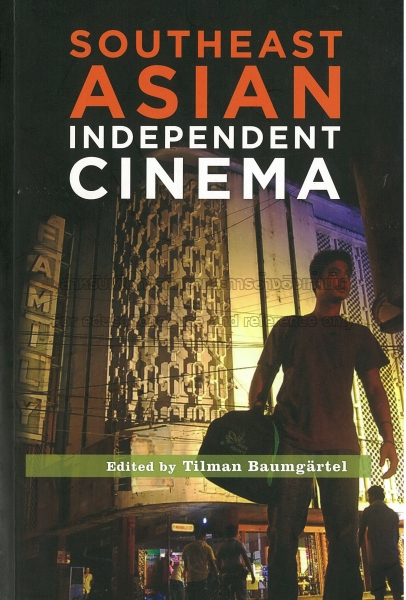
Edited by Tilman Baumgartel
Hong Kong University Press - 2012
By title alone, this book could be easily confused with the Asiexpo publication, Southeast Asian Cinema that appeared several months earlier. There is some overlapping, but not enough to warrant not having both books. The two books might be considered complimentary, as the Asiexpo publication is primarily historical regarding the cinema of the countries covered, while Baumgartel's book is more concerned with a more current state of filmmaking. While the Asiexpo book also includes countries with very little or no cinema, past or present, following a regional overview, Baumgartel concentrates on films and filmmakers from the Philippines, Thailand, Indonesia, Malaysia and Singapore.
The book is divided into three parts - Essays, Documents and Interviews. The first part is the most academic, with discussions based on identities and communities, real and virtual, local and transnational. Much of the idea of an independent cinema is that of filmmakers using relatively inexpensive digital tools and sometimes creating alternative forms of distribution and exhibition. One of the more intriguing chapters, by Nathalie Bohler, discusses oral and performance traditions of Thailand that most famously have been incorporated into the films of Apichatpong Weerasekathul, particularly, Mysterious Object at Noon. Indonesian cinema come under extra scrutiny with essays and interviews spotlighting the conflicts between the filmmakers, who identify as Muslim, and those representing religious and governmental authority.

Khavn de la Cruz
The documents are from the filmmakers, their own stories and manifestos. Filipino filmmaker Khavn de la Cruz takes on Dogme 95 with his own Dogman 2000, followed by a Filmless Manifesto and his Digital Dekalogo. Among the commandments from the Dekalogo: "Work with what you have. Release the bricoleur within. You are not a studio. Accept your present condition. Start here." Of interest to those who write online film criticism, and a riposte to those who believe that only writers of printed media matter, is the essay by Singaporean Tan Pin Pin, and the selling of his performance documentary, Singapore GaGa. "Because the blogosphere was not monolithic and was perceived to be independent, there was a lot more room for conversation and discussion between the readers and the bloggers. Online conversations are just a more efficient way for word of mouth to spread."
With one exception, the interviews are by Baumgartel with Lav Diaz, Brillante Mendoza, Apichatpong Weerasekathul. Pen-Ek Ratanaruang, Nia Dinata, Eric Khoo, as well as one of the last interviews with Yasmin Ahamad before her untimely death at age 51. A common factor is that these filmmakers tend to be better appreciated outside of their home countries, with their reputations based on films that have traveled the international festival circuit. The filmmakers also discuss how they view their films in terms of qualifying the regional or cultural attributes sometimes misapplied or misunderstood by critics and viewers. Pen-Ek describes the people who most appreciate his films, as fans also of musicians "Leonard Cohen, Tom Waits, Bob Dylan and Nick Cave".
This book is part of a series published by Hong Kong University Press, TransAsia: Screen Cultures, with other volumes on different aspects of Asian cinema. Baumgartel has the online blog, Southeast Asian Cinema which has news in English about films and filmmakers often not found elsewhere, as well as fascinating photos of what remains of many movie palaces from the region.

Tan Pin Pin
Posted by Peter Nellhaus at 07:42 AM | Comments (2)
March 26, 2013
GLOW: The Story of the Gorgeous Ladies of Wrestling

Hollywood
Brett Whitcomb - 2012
New Video / Docurama Films Region 1 DVD
Way, way back in the 1950s, when my age was still in the single digits, I watched professional wrestling a few times when in was a staple on broadcast television. I only have the vaguest memory of what I actually watched, but the name of "Haystacks" Calhoun is permanently seared in my brain. There was a time, almost twenty years later, when the buzzword was "semiotics", and I discovered Roland Barthes' delightful essay on wrestling in Mythologies. Later, professional wrestling seemed to be on cultural upswing in the Eighties, with fans to be found among puck rockers and new wave musicians, most notably with the collaborations of Cindi Lauper and "Captain Lou" Albano. Yet I was not prepared for what I saw while channel surfing on a Saturday night in 1986.
It wasn't just a matter of seeing a show devoted solely to wrestling women. It was those rap musical interludes that made me wonder what I had stumbled on. And yes, the novelty did eventually wear off, but for a while there I was hooked. Whatever it was that I was watching, there was nothing else like it, and no way to adequately describe what seemed like a show broadcast from another planet.
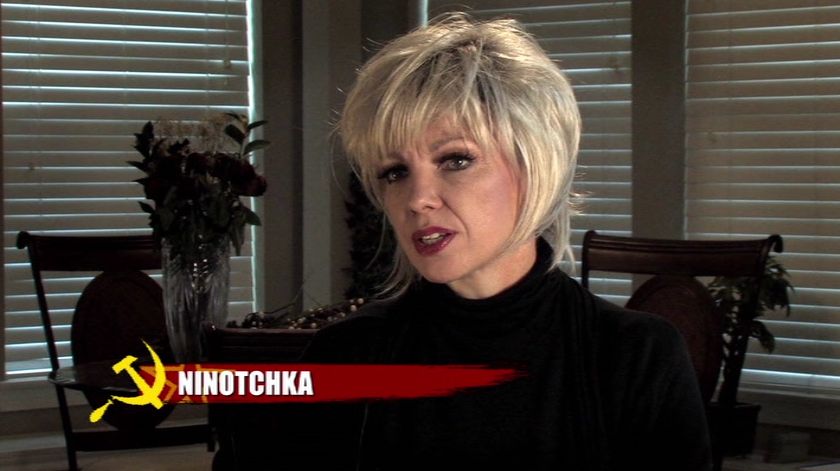
Lorilyn Palmer
What this documentary does best is to reveal the women behind the often outlandish make-up and costumes, as well as some of the men behind the scenes. G.L.O.W. as a television show only last four years. While the plug was pulled unexpectedly, after learning about the physical toll it took on some of the performers, I'm glad not more women were injured. Seeing Susie Spirit's broken arm is a reminder of the reality of professional wrestling.
Part of the story of GLOW is that it was originally conceived by producer David McLane at a time when women's wrestling was a side attraction to the regular bouts between men. It was director Matt Cimber who came up with many of the pseudonyms for the performers, as well as the story lines. The same sensibility that made that Pia Zadora spectacle, Butterfly the subject of extreme critical derision paid off in a show where a lack of taste or subtlety were the main selling points. It was Butterfly producer Meshulam Riklis who financed the show, as well as providing the stage of the Riviera Hotel in Las Vegas. Wrestler Mando Guerrero discusses training in fine art of body flips and writhing in agony. David Blance tells about starting as a staff comedy writer before becoming a part of the cast.
The main story is about the women. Emily Dole, known as Mountain Fiji, was an Olympian shot putter before stepping into the ring. Lisa Moreti, began as Tina Ferrari with GLOW, later becoming Ivory with World Wrestling Entertainment. Before and after she became Matilda the Hun, Dee Booher established herself as one of the top professional female wrestlers. One of the funnier stories, is that due to established rules for women wrestlers, Booher was not allowed to wrestle a man, but did get in the ring with a 750 pound bear. Others, such as Jeanne Basone, appropriately named Hollywood, were among the aspiring actresses who auditioned for what they thought was simply another television show. Almost as hair raising as some the physical abuse from being in the ring, are the stories of the women being required to live in character, with enforced rules of behavior, during their time with GLOW.
Excerpts from the original broadcast, and appearances on daytime talk shows of the day, are cut between the interviews of cast and crew. There are poignant moments, such as the reunion of many of the cast and crew members almost twenty years after that final GLOW broadcast. Best of all are the genuine laughs provoked by some of the memories of being part of a show where what passed for humor would elicit a groan as much as a chuckle.

David Blance as the referee
Posted by Peter Nellhaus at 07:49 AM
March 24, 2013
Coffee Break

Joanna Kulig and Ethan Hawke in Woman in the Fifth (Pawel Pawlikowski - 2011)
Posted by Peter Nellhaus at 07:20 AM
March 21, 2013
Bangkok Revenge

Jean-Marc Mineo - 2011
Well Go USA Entertainment Region 1 DVD
The title evokes images of Muay Thai fighting, and there's some to be found here. That said, this film reminded in some ways of the kind of Hollywood B movies produced in the Fifties, particularly in some of the smart ass dialogue mostly found in the latter half. An example is when the son, Manit, out to revenge the death of his parents, is kidnapped by a gang, and driven to some desolate location. Told that this is the place where he will die, Manit asks to go somewhere nicer. One of the several fights scenes taking place in a confined space, Manit beats the shit out what he calls "the most tasteless gang in Bangkok". OK. Maybe you have to watch the movie to really enjoy the humor.
The debut feature by Jean-Marc Mineo, French actor turned writer-director, Bangkok Revenge is better written than directed. The textbook on how to film action scenes in small spaces is to be found in the first Transporter film. The reliance of quick shots and hyperkinetic editing doesn't work as well, although it is still better than what passes for action in some big budget Hollywood films. One of the better ideas was to film an early fight as giant shadows against a wall. Still, the film's strong suit is the exchange of low brow sarcasm.

Manit is the son of a policeman who was investigating police corruption. As a young boy, he witnesses the murder of his parents, and is himself almost killed. Surviving a bullet to the head, Manit is taken to a small village to heal. The wound leaves him feeling no physical pain or sense of emotion, but doesn't get in the way of learning martial arts or fluent English. The dialogue alternates between Thai and sometimes heavily accented English, so full subtitles help. A running gag regards people asking how Manit speaks fluent English, with his response being, "If I told you, you wouldn't believe me."
Like a lot of classic crime movies, Mineo shoots on the streets of Bangkok, capturing the the congestion of people and traffic. No soi (alley) is too dark, no location too decrepit. The artist cover of one of the villains made me think of Sam Fuller's films with evil disguised by wealth and social position. Adding to the mix of corrupt cops is a female gang, The Hyenas, with one nasty little kick boxing girl, and one obvious ladyboy.
The British Jon Foo may not make the world forget Bruce Lee or Tony Jaa, but he's a good looking guy, and as English is his native language, that is certainly an advantage to the international market. The best known supporting players are two French actors, Caroline Ducey, the lead in Catherine Breillat's Romance, and Michael Cohen, best known for Shall We Kiss?. Veteran Thai actor Winai Kraibutr, who appeared as King Naresuan in the recently reviewed Muay Thai Warrior, briefly is seen as Minat's father.

Posted by Peter Nellhaus at 08:00 AM
March 19, 2013
Hemel
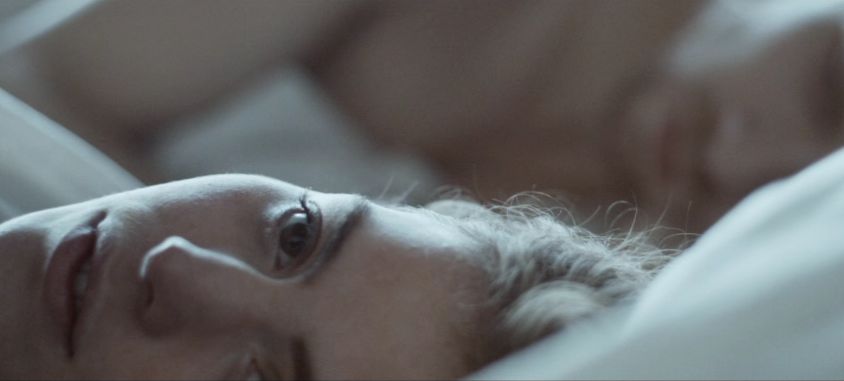
Sacha Polak - 2012
Artsploitation Films Region 1 DVD
For myself, the best parts of Hemel did nothing to propel the narrative, where director Sacha Polak simply let the camera meditate on the face of Hannah Hoekstra. It's not simply a matter of Hoekstra being an attractive young woman. Lots of movies are full of attractive young women. But there is something about the opening shot, looking at her face, taking what seemed like minutes before I realized there was a man, out of focus, besides her. Some of the best moments were watching Hoekstra's long hair whipping around in the wind, as in a scene when she's walking around coast on a cold day. Even Hoekstra's hair has its own character, changing in color from reddish blonde to dark brown, almost black. You don't find that many actors who have the kind of face that the camera loves, at least not recently. The more abstract moments of Hemel were so visually pleasurable that the narrative portions of the film seemed like interruptions.
Hemel, her name is the Dutch word for Heaven, is a young woman going through affairs and one night stands, anchored by father who's known for his series of lovers. The relationship between father and daughter is the most intense of all. The men we see Hemel choose for herself are to greater or lesser degree older. Two of the men are involved with other women, while two have ideas of intimacy that Hemel finds alienating. One of the men insists on chocking Hemel while essentially raping her. Following that scene of rough sex, Hemel visits her step-brother and his fiancee, put off by their choosing celibacy before marriage. The only kinds of relationships Hemel seems to understand are transitory and sexually based.
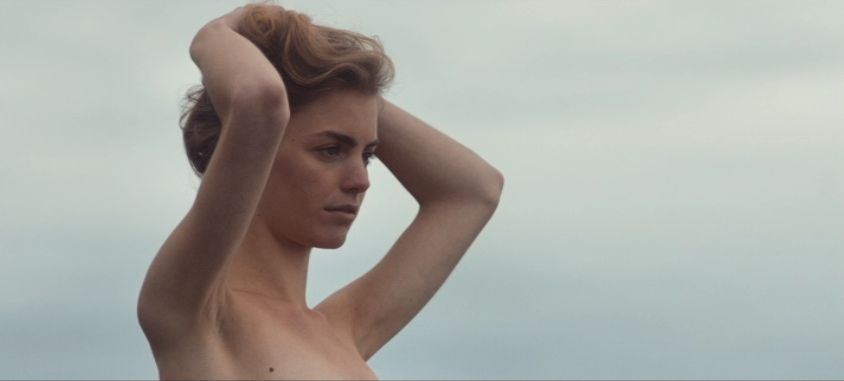
Sacha Polak's debut film, written by Helena van der Meulen, also explores in part how men and women thinks of their own, and each other's, bodies. In the first scene, Hemel has her vaginal area shaved to please a man who declares female pubic hair unhygienic. Hemel is first seen swallowing the man's spit. For Hemel, her response is that the sexual act is unhygienic. This suggests that the "dirtiness" of sex is part of the attraction to Hemel's compulsions. Later, she tells her father that she wants silicon injections in her lips because men find that attractive. Her father sensibly advises Hemel that any man who wants her based on altering the body she was born with is not worthy of her.
While it is not stated as such, Hemel might be said to be at war with her body, or at least the expectations of being born female. The first indication is a shot of Hemel peeing in a toilet standing up. At a nightclub, Hemel states her intentions clearly to a man with whom she wants to have sex. That she demands to be the one in control over her hookups and relishes the idea of having many lovers are traits that traditionally have been deemed as being masculine, and as such have often been the subject of art celebrating male prowess. Hemel's actions are not consciously feminist, nor does the film have an agenda in that regard. The film is non-judgmental of its characters, even when, in the most conventional sense, they behave badly.
Maybe I'm alone here, but I would have been mesmerized by a film just of Hannah Hoeksta. My favorite images from the film are of Hoekstra alone, standing on the beach, riding on the back of truck, or walking along a blue wall. The DVD comes with brief interviews with Hoeksta and Polak, with more in depth discussion with the supplemental booklet. Symbiotic is the operative word here.

Posted by Peter Nellhaus at 08:35 AM
March 17, 2013
Coffee Break
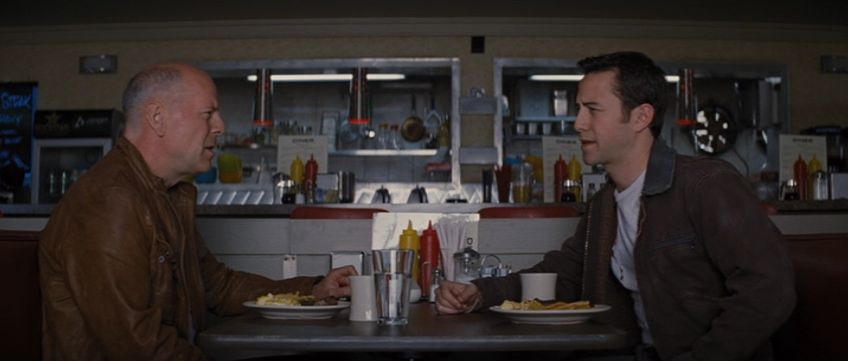
Bruce Willis and Joseph Gordon-Levitt in Looper (Rian Johnson - 2012)
Posted by Peter Nellhaus at 08:44 AM
March 14, 2013
The Great Magician

Daai mo seut si
Derek Yee - 2011
Well Go USA Entertainment Region 1 DVD
There is much to enjoy in Derek Yee's The Great Magician. In a movie about illusions, my favorite scene is of that most trusting of audiences, a group of children. The warlord known as Bully Lei has invited a slew of young children into the theater to watch a performance by the legendary magician, Chang Hsien. For the day's performance, Chang presents an Arabian Nights fantasy with Chang making an entrance on a flying carpet. As part of the performance, a group of female dancers appear in costumes with bare midriffs. Lei is temporarily mesmerized by the women until he turns around to command the children to cover their eyes. Yee cuts to a shot of some of the children obeying the orders, while some of the boys are seen gleefully peeking between their fingers. While much of the story is played for laughs, this one seen is especially joyful.
The illusions, of course, are not limited to the stage. It's little surprise that not everyone is what they appear to be. Chang hopes to reunite with his former fiancee, Yin, now the seventh wife of Lei. The film takes place at an unspecified time in the 1910s, with various warlords fighting with and against each other, while Japan is working to reinstall the monarchy as a puppet government. While rival magicians work sleight of hand, the real illusions are those involving love and power.

The biggest illusion is the romantic rivalry. Both Chang and Lei believe that only they know the way to Yin's heart, and can offer true happiness. Yin remains firmly ambivalent about both men, guided by pragmatism rather than romance. With her high collared dresses as Yin, Zhou Xun plays the often aloof foil to the showier turns of Lau Ching-wan as Lei and Tony Leung Chiu-wai in the title role.
The first scene is of a crowd of prisoners, induced to joining Lei's army with magic tricks that include showers of coins and bread, as well as promises of a better life. Another kind of hunger is on display when Chang performs a trick in which one of Lei's wives is presented with jewelry. Immediately, the other wives clamor to have Chang perform with them, with the last wife presented with a giant sapphire ring.
Illusion is also played with regarding screen images. Lei begins a movie making venture with some Japanese businessmen. In addition to a couple of scenes of audiences watching movies for the first time, a scene that is certainly the fantasy of many studio executives has producer Lei shooting his director. There's even a satirical wink at 3-D. One of Chang's acts involves telling a story with paintings that change as he moves the frame around, ending with what appears to be a real tear coming from the eye of the woman in the portrait. Chang and Lei also appear to fight, seen in shadow against a stage curtain.
For Derek Yee, this is an uncharacteristically light film, with most of the story played for laughs, and something resembling a happy ending. Adding to the fun are Lam Suet, always a joy to see, as the theater owner, and Tsui Hark as a fierce, hook-handed general. The extensive "Making of" supplements discuss the presence of a professional magician who advised Tony Leung's performance and taught him how to do some of the tricks seen in the film. How much of the magic is CGI, traditional cinematic tricks, or actual prestidigitation, I can't say for certain. The best trick in The Great Magician is convincing the viewer that all things are possible.

Posted by Peter Nellhaus at 08:45 AM
March 12, 2013
Death Penalty.com / Death Penalty.com: A New Beginning

Ryota Sakamaki - 2011
TLA Releasing/Danger After Dark Region 1 DVD
I recall one time reading a typical curmudgeonly piece by Herman G. Weinberg, complaining about the apparent decline in Japanese cinema. Where once was Street of Shame was now Street of Joy. Since that time, Seijun Suzuki has become almost as revered as Kenji Mizoguchi.
I don't mean to be obtuse, but sometimes one has to recognize that some films are going to be meaningful to a certain generation or culture. And sometimes the filmmakers are exactly aspiring to make an artistic statement, but simply a statement, to "their" audience. And as someone not part of that audience, I can choose to rant and rave that the current state of cinema, or I can try to figure out what's important here, and why such films might be worth investigating.
What these two films tap into is a sense of hopelessness in Japanese young people. Simultaneously, there is also a disproportionate sense of self when one wants to kill someone else for what many might find trivial reasons. And the idea of getting away with murder has always had some universal appeal. The second film strives to be taken seriously as the game playing is set up as a misguided way for students to take revenge on those who bullied them in the past.

The first film has a interesting premise, with a young man, Ryuta,joining an online group of disgruntled people all in disguise, all using pseudonyms, committing murder for each other. Things get out of hand when Ryuta, known to the group only as "R", has been designated as the next victim by another group member, and is essentially appointed to murder himself. While one might be sympathetic to someone wanting to murder a boss or former spouse, you have to wonder about a girl who seeks revenge over a thoughtlessly destroyed stuffed animal.
Some of the seriousness is undercut in the second film, in which some video programmers get together purportedly to test out a new game version of Death Penalty.com. One of the characters, a young man, wants to kill a young woman, some kind of internet celebrity. The woman in question seems to take on virginal young men for sexual pleasure, with absolutely no interest in anything more than serial single dates. Another guy blames his failure at exam time on another student who played his music too loud. Are Japanese guys that emotionally fragile?

Ryota Sakamaki keeps most of the brutality off screen, although we do see the victims after the mayhem has been committed. Because of the ages of most of the characters and the relatively restrained violence, I have to assume that these films were made primarily for an audience of older teens and younger adults. Setting aside the internet game premise, Sakamaki appears to be addressing the same kind of themes done better in films like Sion Sono's Himizu or Tetsuya Nakashima's Confessions. Sakamaki's films may be more accessible for a certain audience, and for that reason, I have given these films some consideration.

Posted by Peter Nellhaus at 02:25 PM
March 10, 2013
Coffee Break

Don Cheadle in The Guard (John Michael McDonagh - 2011)
Posted by Peter Nellhaus at 08:45 AM
March 07, 2013
Female Teacher: In Front of the Students

Onna kyoshi: Seito no me no maede
Yasuro Uegaki - 1982
Impulse Pictures Region 1 DVD
How problematic is Female Teacher: In Front of the Students? Let me put it to the reader this way - like all of the Impulse Pictures DVDs, this one comes with a two page essay by Jasper Sharp, informative author of Behind the Pink Curtain, about Roman Porno films and filmmakers. Only two paragraphs are actually devoted to this film, and it's easy to understand why;
We're clearly in old school, as it were, male fantasy land here. There the time honored dream of the young male student making it with the attractive teacher. More questionable is the premise, as stated by one of the female teachers, that it is every woman's desire to get raped. I suppose one could get outraged about anybody thinking thinking that the depiction of rape would be a salaryman's entertainment. Maybe I'm taking the easy way out here by classifying Female Teacher: In Front of the Students with the real or perceived racism of Birth of a Nation, or the any number of films as simply the product of a certain time, generation and culture.

The basic premise here is that young, sort of attractive, teacher Reiko gets raped in the shower by a guy wearing a light blue track suit, disguised with a stocking over his face. Is the assailant the boyfriend of best friend Shoko, is it the baddest of bad boy students, or possible the class nerd? Even more troubling is what is everyone reading, with very thick accents, in that English class? I'm guessing by a couple of sentences that it's Jonathan Livingston Seagull, which is scarier than anything seen on the screen here. Anyways, Reiko is left in the shower, with a clue, a piece from a puzzle. I can't totally dislike a film that is unafraid of the most literal minded symbolism.
From what I gather from Jasper Sharp, Yasuro Uegaki had a fairly undistinguished career. Some of the scenes hint that there may have been some slightly higher filmmaking aspirations on Uegaki's part in some of the transitional moments. There are several shots of actress Rushia Santo walking alone, either in school corridors or along the street, alone. The shots are composed so that the viewer is looking ahead at a long, dark pathway. There is also a nicely uneasy scene of Santo alone in her apartment, getting a disturbing phone call. One might also consider the contrast between Reiko's small, cramped apartment and the spacious, opulent home of a student as a comment on class and sexual inequality in Japan.
For the less critical audience, there Reiko's half hearted objections to lesbian sex in the shower with a student, or Reiko's involvement as part of a threesome in front of a huge American flag. The fogging used to cover parts of a scene of bathtub sex could almost be confused with actual steam. There is little information of Rushia Santo, other than that she made four films for Nikkatsu between 1982 and 1986, one directed by the now highly respected Yoichi Sai. Of the Roman Porno films now out on DVD, I would hardly call Female Teacher: In Front of the Students essential viewing, but something more for the more curious students of the genre.

Posted by Peter Nellhaus at 09:36 AM
March 05, 2013
Fairy in a Cage

Ori no naka no yosei
Koyu Ohara - 1977
Impulse Pictures Region 1 DVD
If there was ever a movie that could be compared to a double sided razor, this is it. Fairy in a Cage is best approached carefully. Among the Nikkatsu series of Roman Porno films, extremes are pushed in ways that understandably startled the Japanese male audience of a certain age. Using the Roman Porno framework as a vehicle to attack or at least question certain aspects of Japanese life is not unusual, as has been pointed out previously. What makes Fairy in a Cage notable is that it is simultaneously an exploitation movie centered on sadomasochism and bondage, while also functioning as a harsh critic of the excesses Japanese government and the military during World War II.
Taking place in April, 1941, the film opens on a gathering of various dignitaries and upper level Japanese at an outdoor gathering, with the music of Beethoven playing in the background. A judge, Murayama, casts his eye on one of the guests, the socially prominent Namiji Kikushima. The judge has a taste for ties that bind. With the support of a military officer, some very coincidental evidence is used to imprison Namiji and kabuki actor. While my interest in rope tricks is strictly academic here, it is clear why Naomi Tani was such a popular star in this rough genre.

What has become evident to me is that just as I have been reading Edogawa Rampo to get a clearer understanding of his influence on Japanese horror and fantasy films, so I may need to add Oniroku Dan to my reading list. Even if the films I cover in this series are not directly based on Dan's writings, it would appear that his influence permeates many of these films. While the handful of films I've seen based on Dan's writings are primarily about women held as prisoners by men, Fairy in a Cage includes role reversal. Murayama's mistress and playmate, Kayo, takes advantage of the kabuki actor, a female impersonator on stage, an involuntary stud behind bars. There are also scenes of an officer whose fantasies about Namiji eventually take their toll.
On the politically volatile side is a plot based on characters who questioned or in some way challenged Japanese authority during World War II. In the name of national security, Namiji is imprisoned based on her alleged financing of politically subversive leaflets. The young, idealistic officer who witnesses the punishment of a deserter finds himself questioning his previous sense of loyalty. The film concludes with an indictment of the Japanese military which has reverberations with continued denials of acts that can only be described as criminal.
I had written a bit about Naomi Tani a few years, in the film Madame O. While bondage and S/M are not my cup of chai, Tani seems to have racked up a few credits that are notable for the imagination of the filmmakers. Hopefully, the folks at Impulse Pictures will bring more films starring Ms. Tani in the future.

Posted by Peter Nellhaus at 08:18 AM
March 03, 2013
Coffee Break

Ingvar Eggert Sigurdsson in Reykjavík Rotterdam (Oskar Jonasson - 2008)
Posted by Peter Nellhaus at 08:47 AM
